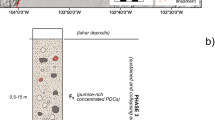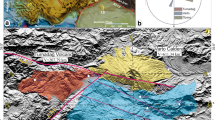Abstract
Magmatic necks are commonly found in volcanic areas, and they often exhibit a homogeneous structure with a cylindrical shape and a diameter of up to several hundreds of metres. Their massive and uniform structure poses a space problem for their emplacement in the brittle crust. Here, we use field data and analogue models to investigate how necks may emplace at shallow levels. Field analysis focuses on characterising the geometric, structural and magmatic features of two necks outcropping in the eroded portions of Mt. Etna, Italy. These are homogeneous and massive intrusive bodies, related to a single episode of emplacement at 400–600 m below the paleosurface. We further investigated their possible emplacement mechanism through analogue models, injecting vegetable oil within (a) a flat sand pack and (b) a sand cone. Dikes form with both configurations, erupting to the surface through vents. However, dikes injected within the cone are characterised by a larger thickening at shallow levels, in correspondence with the vent, where a neck-like structure forms. This suggests that the gravitational load imposed by a volcanic edifice provides the most suitable conditions for the development of magmatic neck, as the downslope shear stresses enhance the deformation of the cone slope during shallow dike emplacement promoting shallow dilation and thickening of the dike. Therefore, topography should be a further factor enhancing the development of necks, in addition to those mechanisms previously proposed. Our results are consistent with natural examples of feeder dikes thickening towards the surface and dikes transitioning to necks, supporting the reliability of the proposed conceptual model.











Similar content being viewed by others
References
Acocella V, Neri M (2003) What makes flank eruptions? The 2001 Etna eruption and its possible triggering mechanisms. Bull Volcanol 65:517–529. https://doi.org/10.1007/s00445-003-0280-3
Acocella V, Neri M (2009) Dike propagation in volcanic edifices: overview and possible developments. Tectonophysics 471:67–77. https://doi.org/10.1016/j.tecto.2008.10.002
Acocella V, Neri N, Behncke B, Bonforte A, Del Negro C, Ganci G (2016) Why does a mature volcano need new vents? The case of the new southeast crater at Etna. Front Earth Sci 4:67. https://doi.org/10.3389/feart.2016.00067
Azzaro R, Bonforte A, Branca S, Guglielmino F (2013) Geometry and kinematics of the fault systems controlling the unstable flank of Etna volcano (Sicily). J of Volcanol Geotherm Res 251:5–15
Billi A, Acocella V, Funiciello R, Giordano G, Lanzafame G, Neri M (2003) Mechanisms for ground-surface fracturing and incipient slope failure associated with the 2001 eruption of Mt. Etna, Italy: analysis of ephemeral field data. J Volcanol Geotherm Res 122:281–294. https://doi.org/10.1016/S0377-0273(02)00507-3
Branca S, Coltelli M, De Beni E, Wijbrans J (2008) Geological evolution of Mount Etna volcano (Italy) from earliest products until the first central volcanism (between 500 and 100 ka ago) inferred from geochronological and stratigraphic data. Intern J Earth Sci 97:135–152. https://doi.org/10.1007/s00531-006-0152-0
Branca S, Coltelli M, Groppelli G (2011a) Geological evolution of a complex basaltic startovolcano: Mount Etna, Italy. Ital J Geosci (Boll Soc Geol It) 130(3):306–317. https://doi.org/10.3301/IJG.2011.13
Branca S, Coltelli M, Groppelli G, Lentini F (2011b) Geological map of Etna volcano, 1:50.000 scale. It J Geosci (Boll Soc Geol It) 130(3):00–00. https://doi.org/10.3301/IJG.2011.15
Brown RJ, Kavanagh J, Sparks RSJ, Tait M, Field M (2007) Mechanically disrupted and chemically weakened zones in segmented dike systems cause vent localization: evidence from kimberlite volcanic systems. Geology 35(9):815–818
Bruce PM, Huppert HE (1990) Solidification and melting along dikes by the laminar flow of basaltic magma. In: Ryan MP (ed) Magma transport and storage. Wiley, London, pp 87–101
Calvari S, Groppelli GL, Pasquarè G (1994) Preliminary geological data on the south-western walls of Valle del Bove, Mt. Etna (Sicily). Acta Vulcanol 5:15–30
Calvari S, Tanner LH, Groppelli GL, Norini G (2004) A comprehensive model for the opening of the Valle del Bove depression and hazard evaluation for the eastern flank of Etna volcano. In: “Etna volcano laboratory”, Bonaccorso, Calvari Coltelli, Del Negro, Falsaperla (Eds.), AGU (Geophysical monograph), 143 65–75
Carey RJ, Houghton B, Sable J, Wilson C (2007) Contrasting grain size and componentry in complex proximal deposits of the 1886 Tarawera basaltic Plinian eruption. Bull Volcanol 69(8):903–926
Corsaro RA, Neri M, Pompilio M (2002) Paleo-environmental and volcano-tectonic evolution of the south-eastern flank of Mt. Etna during the last 225 ka inferred from volcanic succession of the «Timpe», Acireale, Sicily. J Volcanol Geotherm Res 113:289–306. https://doi.org/10.1016/S0377-0273(01)00262-1
De Beni E, Branca S, Coltelli M, Groppelli G, Wijbrans J (2011) 40Ar/39Ar isotopic dating of Etna volcanic succession. It J Geosci (Boll Soc Geol It) 130(3):00–00. https://doi.org/10.3301/IJG.2011.14
Delaney PT, Pollard DD (1981) Deformation of host rocks and flow of magma during growth of minette dikes and breccia bearing intrusions near Ship Rock, New Mexico. USGS Prof Pap 1202:61
Dieterich JH (1988) Growth and persistence of Hawaiian volcanic rift zones. J Geophys Res Solid Earth 93(B5):4258–4270. https://doi.org/10.1029/JB093iB05p04258
Ferlito C, Cristofolini R (1989) Geologia dell’area sommitale dell’Etna. Boll Acc Gioenia Sci Nat 22:357–380
Ferrari L, Garduno VH, Neri M (1991) I dicchi della Valle del Bove, Etna: un metodo per stimare le dilatazioni di un apparato vulcanico. Mem Soc Geol It 47:495–508
Francalanci L, Lucchi F, Keller J, De Astis G, Tranne CA (2013) Eruptive, volcano-tectonic and magmatic history of the Stromboli volcano (north-eastern Aeolian archipelago). Geol Soc Lond Mem 37(1):397–471. https://doi.org/10.1144/M37.13
Galindo I, Gudmundsson A (2012) Basaltic feeder dykes in rift zones: geometry, emplacement, and effusion rates. Nat Hazards Earth Syst Sci 12:3683–3700. https://doi.org/10.5194/nhess-12-3683-2012
Galland O, Holohan E, De Vries BVW, Burchardt S (2015) Laboratory modelling of volcano plumbing systems: a review. In: Nemeth K (ed) Advances in volcanology. Springer, Berlin, Heidelberg, pp 1–68
Geshi N, Kusmoto S, Gudmundsson A (2010) Geometric difference between non-feeder and feeder dikes. Geology 38:195–198. https://doi.org/10.1130/G30350.1
Giammanco S, Melián G, Neri M, Hernández PA, Sortino F, Barrancos J, López M, Pecoraino G, Perez NM (2016) Active tectonic features and structural dynamics of the summit area of Mt. Etna (Italy) revealed by soil CO2 and soil temperature surveying. J Volcanol Geotherm Res 311:79–98. https://doi.org/10.1016/j.jvolgeores.2016.01.004
Gray TGF (1992) Handbook of crack opening data: Cambridge, UK, Abington Publishing, 96 p
Hallett RB (1992) Volcanic geology of the Rio Puerco necks: New Mexico Geological Society. Guidebook 43:135–144
Hooten JA, Ort MH (2002) Peperite as a record of early-stage phreatomagmatic fragmentation processes: an example from the Hopi Buttes volcanic field, Navajo Nation, Arizona, USA. J Volcanol Geotherm Res 114(1–2):95–106
Keating GN, Valentine GA, Kier DJ, Perry FV (2008) Shallow plumbing systems for small-volume basaltic volcanoes. Bull Volcanol 70:563–582. https://doi.org/10.1007/s00445-007-0154-1
Kieffer G (1985) Evolution structural et dynamique d’un grand volcan poligénique: Stades d’edification et activitè actuelle de l’Etna (Sicile). Univ Clermont-Ferrand II Clermont-Ferrand France, Dissertation
Kiyosugi K, Connor CB, Wetmore PH, Ferwerda BP, Germa AM, Connor LJ, Hintz AR (2012) Relationship between dike and volcanic conduit distribution in a highly eroded monogenetic volcanic field: San Rafael, Utah, USA. Geology 40:695–698
Kwon CW, Sohn YK (2008) Tephra-filled volcanic neck (diatreme) of a mafic tuff ring at Maegok, Miocene Eoil Basin, SE Korea. Geosci J 12:317–329
Lanzafame G, Leonardi A, Neri M, Rust D (1997) Late overthrust of the Appenine-Maghrebian Chain at the NE periphery of Mt. Etna, Italy. C R Acad Sci Paris 324:325–332
Lefebvre NS, White JDL, Kjarsgaard BA (2012) Spatter-dike reveals subterranean magma diversions: consequences for small multivent basaltic eruptions. Geology 40(5):423–426
Lentini F, Carbone S, Guarnieri P (2006) Collisional and postcollisional tectonics of the Apenninic-Maghrebian orogen (southern Italy). Geol Soc Am Spec Pap 409:57–81
Lucchi F, Santo AP, Tranne CA, Peccerillo A, Keller J (2013) Volcanism, magmatism, volcano-tectonics and sea-level fluctuations in the geological history of Filicudi (western Aeolian archipelago). Geol Soc Lond Mem 37(1):113–153. https://doi.org/10.1144/M37.8
Marsh BD (1996) Solidification fronts and magmatic evolution. Min Mag 60:5–40
Marsh BD (2013) On some fundamentals of igneous petrology. Contrib Mineral Petrol 166:665e690
Marsh BD (2015) Magma chambers. In: The encyclopedia of volcanoes, second edn, pp 185–201
McGuire WJ (1983) Prehistoric dyke trends on Mount Etna: implications for magma transport and storage. Bull Volcanol 46:9–22. https://doi.org/10.1007/BF02598242
McGuire WJ, Pullen AD (1989) Location and orientation of eruptive fissures and feeder dykes at Mount Etna; influence of gravitational and regional stress regimes. J Volcanol Geotherm Res 38:325–244. https://doi.org/10.1016/0377-0273(89)90046-2
Motoki A, Campos TF, Fonseca VP, Motoki KF (2012) Subvolcanic neck of Cabugi Peak, state of Rio Grande do Norte, Brazil, and origin of its landform. Rem: Revista Escola de Minas 65(2)
Neri M, Acocella V, Behncke B, Giammanco S, Mazzarini F, Rust D (2011) Structural analysis of the eruptive fissures at Mount Etna (Italy). Ann Geophys 54(5):464–479. https://doi.org/10.4401/ag-5332
Norini G, Acocella V (2011) Analogue modeling of flank instability at Mount Etna: understanding the driving factors. J Geophys Res Solid Earth 116:B07206. https://doi.org/10.1029/2011JB008216
Patané G, Agostino I, La Delfa S, Leonardi R (2009) Evolution of volcanism around the eastern sector of Mt. Etna, inland and offshore, in the structural framework of eastern Sicily. Phys Earth Planet Inter 173(3–4):306–316
Re G, White JD, Muirhead JD, Ort MH (2016) Subterranean fragmentation of magma during conduit initiation and evolution in the shallow plumbing system of the small-volume jagged rocks volcanoes (Hopi Buttes Volcanic Field, Arizona, USA). Bull of Volcanol 78(8):55
Rubin AM (1995) Propagation of magma-filled cracks. Annu Rev Earth Planet Sci 23(1):287–336. https://doi.org/10.1146/annurev.ea.23.050195.001443
Ruch J, Pepe S, Casu F, Solaro G, Pepe A, Acocella V, Neri M, Sansosti E (2013) Seismo-tectonic behavior of the Pernicana Fault System (Mt Etna): a gauge for volcano flank instability? J Geophys Res Solid Earth 118:4398–4409. https://doi.org/10.1002/jgrb.50281
Siniscalchi A, Tripaldi S, Neri M, Balasco M, Romano G, Ruch J (2012) Schiavone D (2012) flank instability structure of Mt Etna inferred by a magnetotelluric survey. J Geophys Res 117:B03216. https://doi.org/10.1029/2011JB008657
Solaro G, Acocella V, Pepe S, Ruch J, Neri M, Sansosti E (2010) Anatomy of an unstable volcano through InSAR data: multiple processes affecting flank instability at Mt. Etna in 1994-2008. J Geophys Res 115:B10405. https://doi.org/10.1029/2009JB000820
Sparks RSJ, Baker L, Brown RJ, Field M, Schumacher J, Stripp G, Walters A (2006) Dynamical constraints on kimberlite volcanism. J Volcanol Geotherm Res 155:18–48
Thielicke W, Stamhuis EJ (2014) PIVlab-towards user-friendly, affordable and accurate digital particle image velocimetry in MATLAB. J Open Res Soft 2(1). https://doi.org/10.5334/jors.bl
Townsend M, Pollard DD, Jhonson K, Culha C (2015) Jointing around magmatic dikes as a precursor to the development of volcanic plugs. Bull Volcanol 77:92. https://doi.org/10.1007/s00445-015-0978-z
Vigneresse JL, Tikoff B, Améglio L (1999) Modification of the regional stress field by magma intrusions and formation of tabular granitic plutons. Tectonophysics 302:203–224. https://doi.org/10.1016/S0040-1951(98)00285-6
White JDL, Ross PS (2011) Maar-diatreme volcanoes: a review. J Volcanol Geotherm Res 201(1–4):1–29
Wright TL, Klein FW (2014) Two hundred years of magma transport and storage at Kilauea Volcano, Hawaii. 1790e2008. U.S. Geological Survey Professional Paper, Washington, D.C, https://doi.org/10.3133/pp1806
Author information
Authors and Affiliations
Corresponding author
Additional information
Editorial responsibility: J. Taddeucci
Electronic supplementary material
ESM 1
(DOC 47 kb)
Fig. S1
Field view of Neck 2. (JPG 364 kb)
Fig. S2
Detailed picture showing the homogeneous texture and several mm to cm-sized phenocrysts of pyroxene. (JPG 332 kb)
Fig. S3
Band of thermal alteration along the contact between Neck 2 and Py deposit. (JPG 484 kb)
Fig. S4
a) figure showing the mean strike direction of the dikes (yellow line) that is radial to the Ellittico caldera paleosummit; b) main faults affecting the eastern flank of Mt. Etna. (JPG 245 kb)
Table S1
(DOC 30 kb)
Table S2
(DOC 32 kb)
Rights and permissions
About this article
Cite this article
Fittipaldi, M., Urbani, S., Neri, M. et al. Understanding the origin of magmatic necks: insights from Mt. Etna volcano (Italy) and analogue models. Bull Volcanol 81, 11 (2019). https://doi.org/10.1007/s00445-019-1273-1
Received:
Accepted:
Published:
DOI: https://doi.org/10.1007/s00445-019-1273-1




